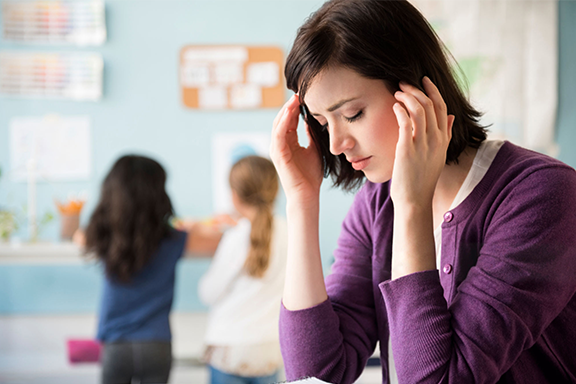
By teacher guest blogger Kathryn Rose
Winter break has come to a close but, for many teachers and administrators, their classrooms and schools are still not entirely open. A new surge of Covid-19 cases is sweeping across the country, harkening back to the early days of the pandemic, and it would be an understatement to say that everyone is tired.
We are all tired.
But teachers have to be okay.
Let me phrase that a little differently -- we are depending on educators to be okay but teachers do not have the luxury of crying between zoom calls. They have children to greet, connect with and console. They have school-wide testing concerns and personal health concerns and a massive amount of curriculum that they are trying to cover. It was hard enough to take a sick day when the world was a “normal” place to live in and yet, within the fog of the pandemic, the world still wants schools to post their open sign on the front door.
Many of us are hardly ready for our regularly scheduled academic programming, and the deficit between expectations and reality is pushing a lot of educators into complete exhaustion,if not out of the profession altogether. In an Education Week article titled, Teachers Are Not Okay, Even Though We Need Them To Be, Anne Sylvester, a former high school English teacher who left her school after 25 years of teaching to protect her own mental health, summed it up perfectly.
“I’ve never burned out on the kids. I’ve never burned out on my subject. I’ve always enjoyed teaching, but the rest of it is exhausting and chronic.”
Chronic. The pain and trauma of the past few years is now a chronic condition experienced by many teachers all over the country. And what advice do we give some of the most valued members of our community?
Mostly, self-care.
However, this lack of preparation comes at a cost with some teachers, who report that they lose over 144 minutes of instructional time due to dealing with weekly behavioral disruptions. A lack of classroom management leads to quick burnout for both students and teachers.
Don’t get me wrong, self-care is important. There is nothing wrong with getting enough sleep, eating healthy meals, or finding time to exercise or meditate. But, yet again, we are asking educators to carve out precious personal time to save themselves from the established systems and conditions that are causing them to completely burn out in the first place.
So if we aren’t passing out bottles of bubble bath, blankets, and wine, what can be done?
First of all, the entire school community could take responsibility for the systemic problems that cause teacher collapse. While everyone involved in an educational setting plays a special part in the school’s overall culture, educators actually have a smaller impact on the larger changes that would make their jobs less stressful. They cannot dictate scheduling, separation of out-of-classroom duties, or accountability systems. This responsibility lies squarely on the shoulders of administrators.
In Sean Slade & Alyssa Gallagher article, ‘A Culture of Care’: How Schools Can Alleviate Educator Stress This Year, they assert that “Principals have the power to set the tone and establish a new order of business in a school. The principal provides education credibility to almost any initiative they champion, and as such, most school teams buy-in.”
Principals are in the unique position to help the rest of the school community “buy-in” to the concept that schools, on a systematic level, need to be structured in such a way that provides regular support for teachers through appropriate communication and expectations. We don’t need administrators to try to alleviate an entire pandemic-sized level of stress with (often unhelpful) self-care strategies. It’s an impossible task. But administrators can target the underlying causes of a stressful school culture that can ultimately lead to teacher burnout.
How can administrators begin to unravel and rebuild their school’s culture? Every school culture is different and every community has different needs, but all principals can start by trying to improve the ways in which community members interact with one another. This includes demonstrating compassionate collaboration, active listening, and regular acknowledgment of individual skill sets and limitations. Principals can set a tone that encourages everyone to build their school into a place of positive interactions that buffer everyday stress.
Ultimately, if we expect teachers to continue through this pandemic at a regular pace, then it is everyone’s responsibility to ensure that schools are safe and supportive environments. Administrators play an important leadership role in this endeavor but each of us with a role in education can play a part.
Our teachers are not okay - but we desperately need them to be.
------------------------------------------
About Kathryn Rose
Kathryn Rose is currently a virtual tutor and a museum resource teacher. She also freelances for businesses and startups in the education field. She has taught at her city’s botanic garden for 12 years and has been a Social Studies teacher in both private and public schools.


